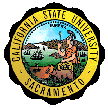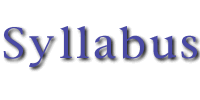

Chemistry 110
Inorganic Chemistry
California State University, Sacramento
Course
Objectives
Reading
Materials
Other
Materials
Grades
Assignments
Course
Units
Catalog Description: The application of atomic structure, the periodic law, molecular structure and bonding principles, electrochemical principles and other selected models and concepts of theoretical and descriptive inorganic chemistry. Physical and chemical properties of selected elements and inorganic compounds are studied. You must take Chemistry 110L , Inorganic Laboratory, concurrently with the lecture course.
- Understand the basic principles of inorganic chemistry.
- Understand the role of inorganic chemistry as it is related to the other areas of the discipline such as biochemistry, analytical, physical, etc.
- Solve theoretical problems and be able to apply the solutions to practical problems.
- Use various tools of technology for communication, source of information, molecular modeling etc.
- Refer to the course calendar for a quick overview of reading assignments, exams and events.
- List Serve Activities
Listproc@csus.edu
subscribe Chem110-L firstname lastname
end
the instructor, mail it to borer@csus.edu.
- Problems are assigned
from Bowser. Problems are
due one week after the chapter has been discussed
in lecture.
Homework 1. Chapter 1. 4, 7, 12, 13, 15, 17, 20.
Draw out the microstate table for a d2 ion. Determine all energy states. Draw an energy diagram.
Homework 2. Chapter 2. 1, 2, 5, 6, 7, 9, 11.
Look at more than one flowchart of assigning point groups. Suggest which you prefer and why.
Homework 3. Chapter 3. 2, 3, 4, 5, 7, 9, 11, 14, 16, 20.
Use HyperChem to draw carbon monoxide. Record the MO diagram for it. Label the HOMO and LUMO orbitals.
Draw CO, NO, N2, and O2. List the four molecules in order of increasing HOMO-LUMO gap. Which molecule would be the "softer"?
Homework 4. Chapter 4. 1, 3, 4, 5, 8, 12, 18, 20, 23, 27.
Compare some of the ideas of G. N. Lewis and Linus Pauling on covalent bonding. In your opinion, which do you think was more correct? Defend your choice.
Homework 5. Chapter 5. 1, 4, 5, 6, 15.
Draw NO2Cl using VSEPR theory. Estimate bond angles and distances. Draw the molecule using Spartan and determine the geometry, angles, and distances. Compare your responses.
Homework 6. Chapter 6. 1, 9, 16, 21, 24. and Chapter 7. 3, 7, 9.
Find a site on the Internet which shows three dimensional diagrams of solid state materials. Use the class listserve to post the URL address for the class to use. The subject "URL address" must be used in your mailing.
Find a recent article in the CSUS library which discusses a fullerene or a silicate. Write a short synopsis of the article and post your synopsis to the listserve for the class to read. The subject "Synopsis" must be used in your mailing.
Homework 7. Chapter 8. 6, 12 and Chapter 9. 3, 4, 15, 19,.
Homework 8. Chapter 10. 1, 3, 5, 10, 12, 15, 19, 24, 29.
Which of the acid-base theories is most beneficial to a biochemist? Defend your choice.
Homework 9. Chapter 15. 2, 6, 9, 12, 13, 14, 19, 22.
Find an article on the Internet which discusses a use of a specific transition metal. Evaluate the usefulness of this application to society. Use the class listserve to post the URL address AND your opinion paper. The subject "Transition Metal" must be used in your mailing.
Homework 10. Chapter 16. 1, 2, 3, 5, 7, 10, 12, 17, 21.
Compare the coordination bonding theories.
Homework 11. Chapter 21.4, 7, 8, 9, 10, 11, 12, 18, 20, 28, 29.
Draw ammonia in either HyperChem or Spartan. Using the IR application, determine the number of degrees of freedom.
Homework 12. Chapter 17. 5, 9, 17, 19, 20, 24, 25, 26.
Henry Taube and Rudolf Marcus both received a Nobel Prize for their contributions to chemistry. Use your access to Internet to determine what research activities lead to the award.
Homework 13. Chapter 18. 1, 13, 15, 17, 23, 25, 28, 33, 30 and Chapter 19.
Use Spartan to draw one of the molecules shown in problem 32. Determine the point group symmetry.
Find an Internet site which shows clusters or cages. Discuss the nature of one of the compounds. Use the class listserve to post the URL address AND your opinion paper. The subject "Cluster" must be used.
Homework 14. Chapter 22. 1, 3, 5, 7, 9, 16, 19, 20.
Find an Internet site which displays biological molecules such as hemoglobin, myoglobin, chlorophyll, ferredoxins. etc. Use the class listserve to post the URL address for others to access. The subject "bioinorganic" must be used.
- Seminar Topics
Electron deficient compounds of boron and/or aluminum
Organometallic Compounds: metal carbonyls, metal-metal bonds, catalysis.
Bioinorganic Chemistry: copper, iron, zinc, molybdenum, cobalt, alkali and alkaline earth metals in biochemistry.
Model complexes for nitrogen fixation, oxygen carriers, photosynthesis, electron transfer.
Therapy: chelation with EDTA, antitumor agents such as platinum complexes, chromium picolinate, heaavy metal poisoning.
Solar photochemistry
Inorganic polymers
The seminar should be approximately 10 min. in length. You should use Power Point, or some similar type of program, to prepare your slides. The accompanying paper should be approximately 5 pages in length and have at least 5 current references.
Exams
150 pts each
450
Homework
14 at 20 pts each
280
Seminar
10 min
100
Final Exam
.
170
Total
.
1000

Required: The text for the course this semester is
Inorganic Chemistry/ James Bowser
Other Inorganic books that are useful are:
- Concepts and Models of Inorganic Chemistry/Douglas, McDaniel, Alexander
- Inorganic Chemistry/F.A. Cotton
Suggested Readings: The list below contains supplemental readings pertaining to the course.
- List other reference books
- Link to web resources listed on the Course Resources page
Course Unit 1:Title of Course Unit links to units.htm page
Course Unit 2:Title of Course Unit links to new unit page
Course Unit 3:Title of Course Unit links to new unit page
Course Unit 4:Title of Course Unit links to new unit page
Course Unit 5:Title of Course Unit links to new unit page
DEPARTMENT / CSUS